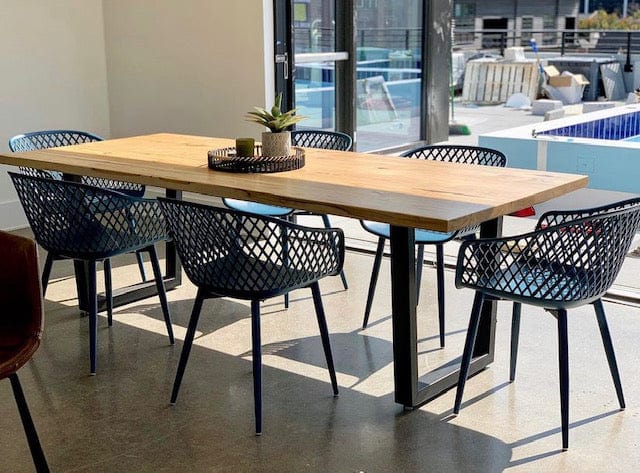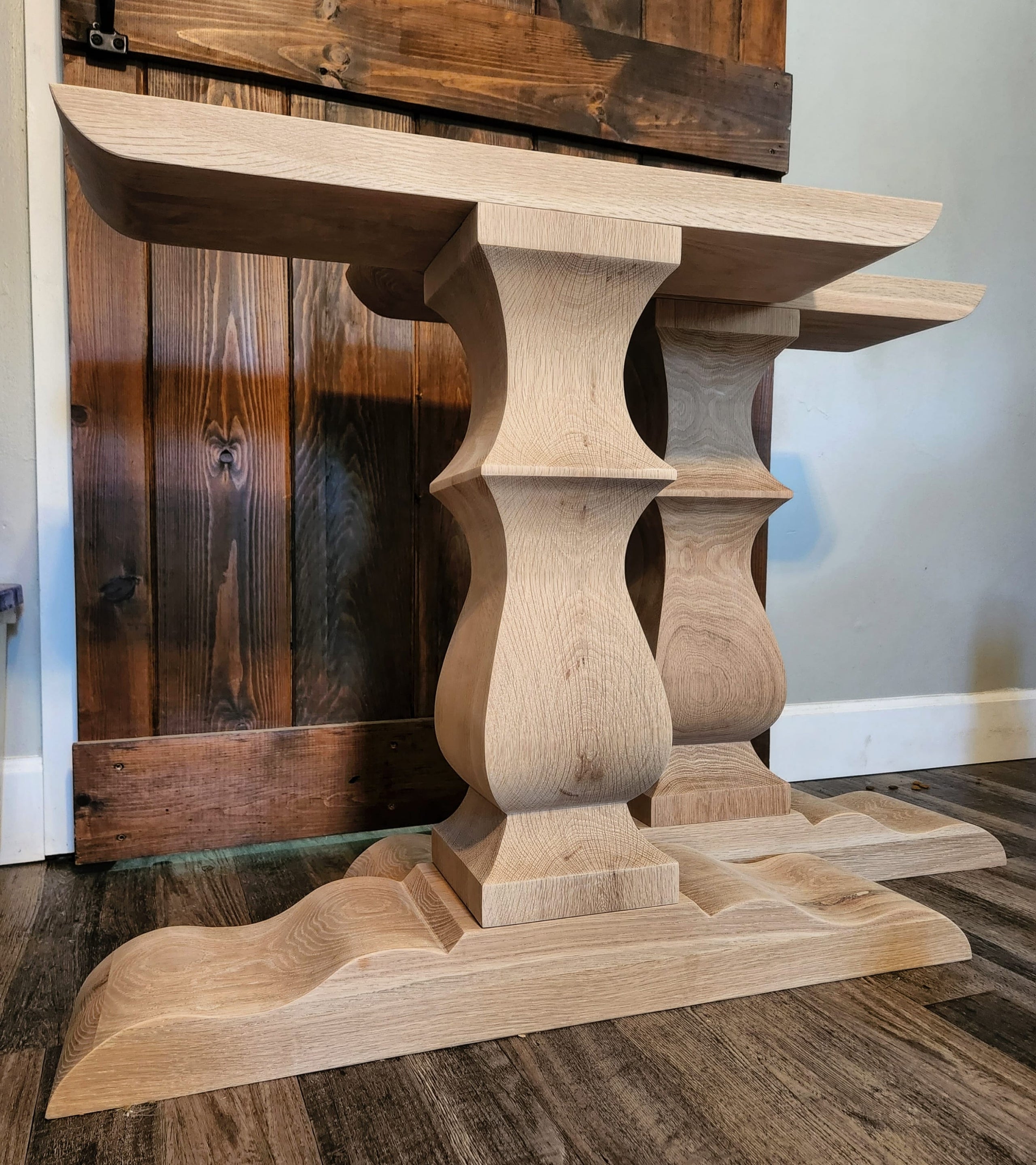Dining Room Table Legs That Combine Performance and Modern Layout
Dining Room Table Legs That Combine Performance and Modern Layout
Blog Article
Picking the Perfect Eating Table: What Styles Work Best for Your Home?
Selecting the suitable eating table for your home can be a nuanced procedure that stabilizes aesthetic appeals and capability. Whether your room leans in the direction of traditional style, contemporary minimalism, rustic appeal, or commercial elegant, the range of styles available can deal with diverse tastes. Each layout offers one-of-a-kind benefits and obstacles that can either improve or interrupt your eating location's harmony. Understanding how various products, shapes, and dimensions communicate with your existing design is critical. To navigate these selections properly and find a table that genuinely enhances your home, consider the adhering to facets carefully.
Examining Your Space
Examining the measurements and format of your eating location is a vital very first step in selecting the ideal eating table. Begin by determining the length and size of the space, representing entrances, home windows, and other building features that could influence table positioning. This ensures that your table not just fits however additionally permits comfy activity around it.
Think about the number of individuals you generally amuse. A table needs to suit your household's day-to-day demands while using sufficient adaptability for occasional guests. As a rule of thumb, designate at least 24 inches of table size each to make certain a comfy dining experience.
It's additionally essential to keep ideal clearance around the table. Ideally, there ought to be at least 36 inches between the table side and walls or various other furniture, enabling simple access and activity. For rooms where chairs with arms or added storage devices like buffets are included, boosting this clearance to 48 inches is advisable.
Lights and atmosphere play considerable functions. Guarantee that your eating table aligns with existing lighting components or strategy for appropriate lights options. This comprehensive spatial evaluation assurances that your table not just fits literally yet also integrates with your room's general performance and visual.
Popular Table Styles

Typical eating tables commonly include elaborate details, curved legs, and abundant timber surfaces, stimulating a sense of classic sophistication. They are perfect for homes with traditional style or those aiming to add a touch of refinement to their eating area.
Modern eating tables prioritize simpleness and tidy lines, frequently including materials like glass and steel. These tables are excellent for modern spaces, giving a sleek and clean appearance that matches minimal style viewpoints.
Rustic eating tables, on the various other hand, highlight all-natural materials and a handmade look - dining room table legs. They often include recovered wood and a distressed finish, producing a cozy and inviting atmosphere. These tables function well in farmhouse-style homes or those looking for a comfortable, natural feeling
Industrial dining tables incorporate raw materials such as steel and timber, typically showcasing a practical visual. This design is well-suited for loft spaces or metropolitan areas, adding a touch of rugged appeal and resilience to the eating experience.
Each design uses unique advantages, making it necessary to choose one that aligns with your home's general layout and your individual choices.
Product Choices
When selecting a table, the selection of product plays an essential function in figuring out both the table's visual appeals and performance. Timber, metal, glass, and composite materials each deal one-of-a-kind benefits and difficulties, making it essential to line up the product with your home's design and way of living requirements.
Wood is an ageless and flexible alternative, readily available in varieties such as oak, walnut, and mahogany. Understood for its longevity and warmth, timber matches both traditional and modern interiors. However, it needs normal upkeep to stop scrapes read what he said and bending.
Steel tables, commonly crafted from stainless steel, light weight aluminum, or wrought iron, are applauded for their contemporary appeal and effectiveness. They are specifically suited for industrial or minimal setups but can be susceptible to damages and might really feel chilly to the touch.
Glass table bring an air of sophistication and visibility, ideal for smaller sized rooms as they produce image source an impression of even more room. While simple to clean, glass can be vulnerable to smudges and requires mindful handling to prevent chips and splits.
Composite materials, such as MDF and plywood, deal economical and customizable options, though they may lack the durability of all-natural materials. Choosing the right material guarantees your dining table is both a functional asset and a visual delight.
Sizes And Shape Considerations
After determining the ideal material for your dining table, the following factor to consider is choosing the best form and size to fit your room. The form of the table significantly affects the space's aesthetic and functionality. Rectangle-shaped tables, the most usual shape, are ideal for bigger spaces and can fit a greater variety of guests. They likewise enable for an extra official eating experience. Conversely, round tables foster a sense of affection and are exceptional for smaller sized dining locations, motivating conversation by getting rid of corners and making every person really feel just as consisted of.
As a policy of thumb, allot at least 24 inches of table width per person to make certain comfortable dining. Furthermore, consider the table's clearance area: there ought to be at least 36 inches in between the table side and the walls or other furniture. Prolonging tables offer adaptability if you frequently host bigger gatherings, offering additional seats when required without inhabiting additional room daily.
Matching Your Style
Picking a table that harmonizes with your existing design is crucial in developing a natural and inviting room. Begin by assessing your current interior decoration style, whether it be contemporary, typical, rustic, or diverse. The eating table need to enhance the overall aesthetic, not compete with it. A sleek, minimalist table with tidy lines is optimal for a contemporary home, while a vintage, ornate table suits a much more conventional setup.
If your design features cozy tones and natural products, consider a wooden table to improve the natural feel. Alternatively, a glass or steel table might be a lot more ideal in an area controlled by cool colors and commercial components.
Texture plays a crucial duty too. A rough-hewn, reclaimed timber table can include character to a rustic room, while a refined marble surface can elevate a luxurious eating location. Think about the range and proportion of the table in relation to the space size and existing furnishings. A well-matched table not just boosts aesthetic appeal but likewise enriches the overall eating experience.

Conclusion
Choosing the ideal dining table requires cautious consideration of room, design, products, form, and size (dining room table legs). Typical tables enhance timeless insides with abundant timber finishes, while contemporary tables match modern setups via glass and metal. Rustic styles introduce warmth by means of all-natural materials, and industrial designs boost urban atmospheres with raw components. Harmonizing the dining table with existing design ensures both performance and visual allure, adding to a natural and visually index pleasing eating location.
Report this page